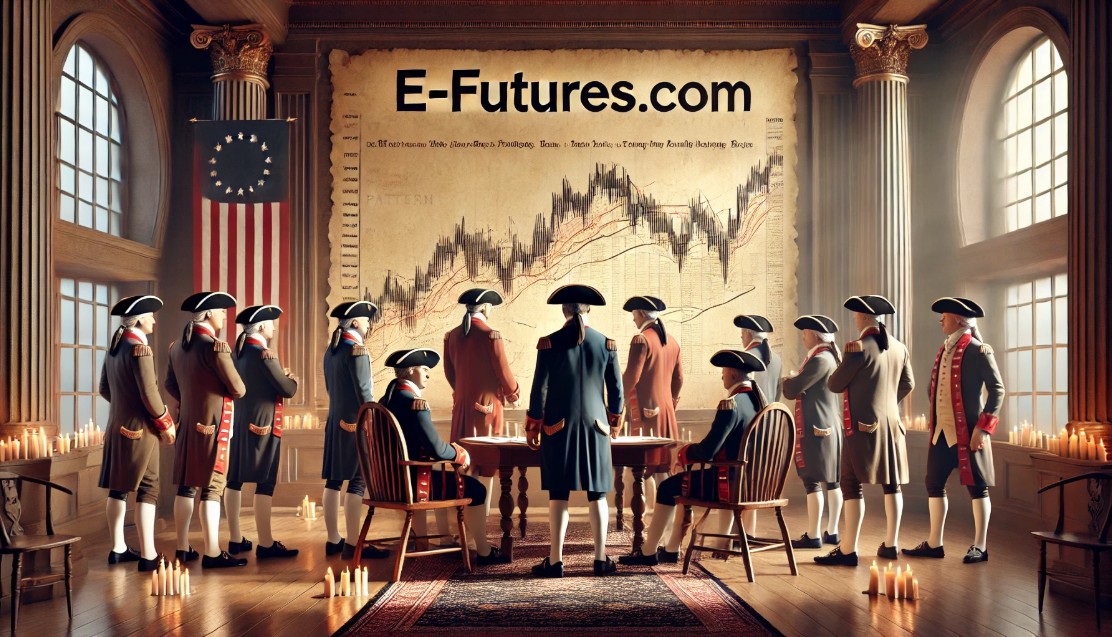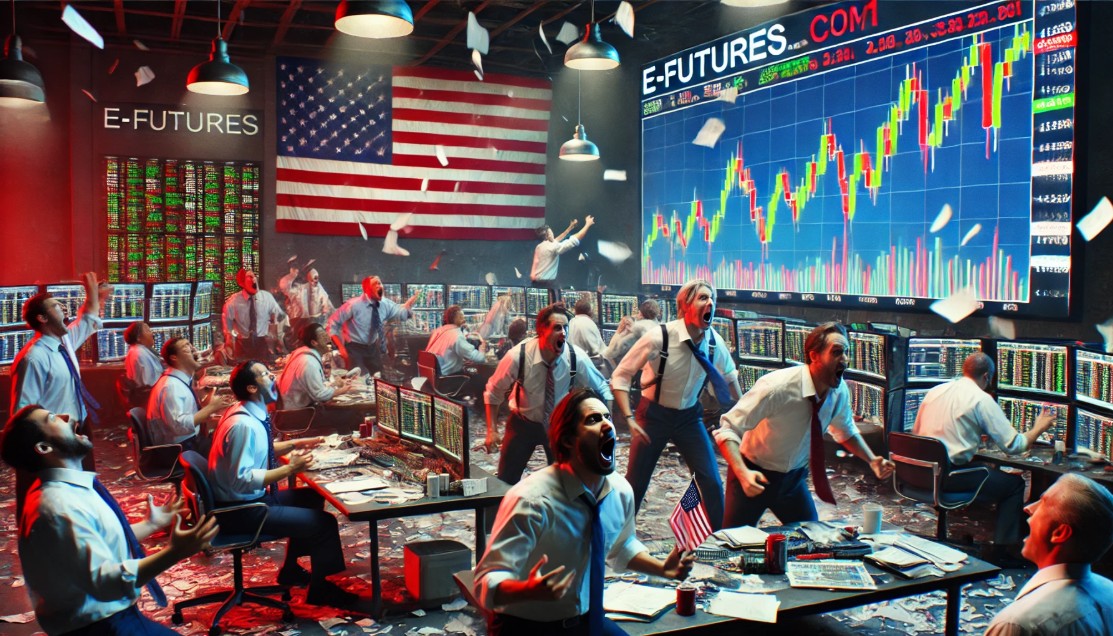Futures trading has long stood as a cornerstone of modern financial markets. This powerful financial instrument enables individuals and institutions to hedge against risk, speculate on price movements, and gain exposure to a broad range of asset classes. Whether you’re trading futures for crude oil, agricultural commodities, indices, or interest rates, the versatility and potential of the futures market are vast.
As we move through 2025, the conversation around futures trading is more relevant than ever. Market volatility, macroeconomic shifts, evolving geopolitical landscapes, and advancements in trading technology are all converging to create both opportunities and challenges for traders.
This comprehensive guide explores:
- The personal and professional benefits of futures trading,
- The risks new traders must mitigate,
- How a seasoned futures broker like E-Futures.com can support new and experienced traders alike, and
- What all traders can expect in the second half of 2025.
We’ll also explore why E-Futures.com, with its consistently top-rated service on TrustPilot, its renowned compliance record, and its advanced CannonX powered by CQG trading platform, stands out as one of the best futures brokers in the world.
The Personal and Professional Benefits of Futures Trading
- High Leverage Potential
One of the defining traits of futures trading is its leverage. Futures contracts typically require a small margin deposit—often just a fraction of the contract’s notional value. This means traders can control large positions with relatively small capital.Personal Benefit: This allows retail traders to maximize returns on limited capital.
Professional Benefit: Institutional traders can allocate capital more efficiently across portfolios while managing exposure across multiple assets.
- Portfolio Diversification
Futures trading offers access to a vast array of global markets, including commodities, currencies, interest rates, equities, and even crypto-based contracts.Personal Benefit: Traders can hedge their stock portfolios or gain exposure to markets like energy or agriculture that might be otherwise inaccessible.
Professional Benefit: Money managers and institutions can fine-tune risk and build diversified hedging strategies using futures.
- Liquidity and Transparency
Futures markets are among the most liquid in the world, especially for products like the S&P 500 E-mini or crude oil contracts.Personal Benefit: Easy trade entry and exit at competitive prices.
Professional Benefit: High liquidity ensures institutional strategies can be executed efficiently without significant slippage.
- Around-the-Clock Trading
Many futures markets operate nearly 24 hours a day, five days a week. This global trading calendar allows traders to react to breaking news and market-moving events in real time.Personal Benefit: Greater flexibility for individuals with day jobs or non-traditional schedules.
Professional Benefit: Institutions can respond swiftly to global economic changes or hedge positions during international trading sessions.
- Tax Efficiency and Regulation
In the U.S., futures contracts may qualify for 60/40 tax treatment—60% of gains taxed at long-term rates and 40% at short-term—regardless of how long the trade was held.Personal Benefit: Potential tax savings for active traders.
Professional Benefit: Clear CFTC regulations and standardization help reduce counterparty risk and operational uncertainty.
Risks of Futures Trading That New Traders Must Mitigate
While the advantages are significant, trading futures comes with equally important risks—especially for newcomers.
- Leverage Cuts Both Ways
While leverage amplifies gains, it also magnifies losses. A small adverse price movement can result in margin calls or full account liquidation.Mitigation Tip: Beginners should start with smaller positions and never risk more than a small percentage of their capital on a single trade.
- Market Volatility
Futures markets can be highly volatile. Sudden price swings driven by geopolitical events, weather, or central bank decisions can lead to significant losses.Mitigation Tip: Always use stop-loss orders and predefined risk-reward ratios.
- Lack of Understanding
Many new traders enter futures trading with only a superficial understanding of the market, contract specifications, or margin requirements.Mitigation Tip: Education is critical. Partner with a broker that provides detailed tutorials, demo accounts, and direct support.
- Overtrading and Emotional Decisions
The fast-paced nature of futures can lure traders into overtrading or making impulsive decisions based on emotion rather than analysis.Mitigation Tip: Develop a clear, rule-based trading plan and stick to it.
- Technical Platform Errors
Slippage, system outages, or poor connectivity can disrupt your ability to execute or exit trades.Mitigation Tip: Use a reliable futures trading platform like CannonX powered by CQG, known for speed, reliability, and precision.
How Your Futures Broker Can Help You Navigate the Challenges
Your choice of broker will be one of the most important decisions in your trading journey. The best futures broker doesn’t just execute your trades—they guide, educate, and protect you.
- Education and Support
Top brokers like E-Futures.com offer detailed trading tutorials, live webinars, and 1-on-1 support to help you understand everything from contract specs to risk management strategies.
- Platform Reliability
A high-performance futures trading platform like CannonX powered by CQG gives traders the tools they need to stay ahead of the curve. With real-time data, advanced charting, and ultra-fast execution, CannonX ensures your technical strategy is never undermined by poor tech.
- Transparent Pricing
E-Futures.com stands out for its transparent commission structures, low fees, and no hidden costs—critical for new traders trying to preserve capital.
- Risk Management Tools
The platform offers built-in tools to set stop-loss, take-profit, bracket orders, and simulate trades with a demo environment.
- Regulatory Compliance and Safety
E-Futures.com is not only highly rated by users on TrustPilot but is also fully compliant with CFTC and NFA regulations. You can trade confidently knowing your broker meets the highest standards of ethical conduct and financial solvency.
What Traders Can Expect from the Markets in the Second Half of 2025
- Continued Volatility in Equities
With continued interest rate decisions from the Federal Reserve and mixed economic signals, volatility is expected to remain high in U.S. equity index futures like the E-mini S&P 500. Expect sharp intraday movements and unexpected reversals.
- Commodity Market Adjustments
Crude oil, gold, and agricultural futures may see significant shifts due to geopolitical tensions in the Middle East and changing climate patterns. Energy traders should monitor inventory data and OPEC decisions closely.
- Strong Institutional Interest in Interest Rate Futures
Interest rate futures will likely gain volume in the second half of 2025, as central banks around the world finalize post-inflationary policy stances. Treasury futures and Eurodollar contracts will be key instruments for professional hedgers.
- Renewed Attention on Currency and Crypto-Based Futures
Expect growing interest in currency futures as global FX volatility returns. Some exchanges may expand their crypto futures offerings in response to regulatory clarity from the SEC and CFTC.
- Technical-Driven Trading Surge
Retail and professional traders alike are increasingly reliant on technical analysis and algorithmic trading. Futures brokers like E-Futures.com that offer integrated tools via CannonX are well-positioned to meet this demand.
Why E-Futures.com Is the Best Futures Broker for Traders at Every Level
- Stellar Reputation Backed by TrustPilot

With hundreds of verified 5-star reviews, E-Futures.com is recognized on TrustPilot as a top-rated futures trading broker. Customers consistently praise their transparency, customer service, and platform performance. - Decades of Industry Experience
E-Futures.com has been guiding traders for over two decades. This longevity speaks to the firm’s integrity, resilience, and customer-focused approach. - Regulatory Excellence
The firm maintains a pristine record with both the Commodity Futures Trading Commission (CFTC) and the National Futures Association (NFA), reflecting an unwavering commitment to regulatory compliance and ethical standards. - Advanced Trading Technology with CannonX Powered by CQG
E-Futures.com provides traders with CannonX, a state-of-the-art futures trading platform built on CQG technology. CannonX combines:
- Ultra-low latency order routing,
- Deep market visibility (DOM),
- Advanced technical indicators and studies,
- Real-time data feeds and charting.
The CannonX powered by CQG interface empowers traders with tools typically reserved for professional trading desks.
- Support Tailored to Every Experience Level
From onboarding a brand-new trader with a demo account to assisting institutional clients with custom APIs and automation, E-Futures.com caters to a wide array of users. The firm’s support team is known for rapid response times and in-depth platform knowledge.
Futures trading offers immense potential—for both personal enrichment and professional achievement. From diversification and tax efficiency to strategic leverage and market access, trading futures is a robust avenue for both novice and advanced traders.
Yet, these benefits do not come without risk. The fast-paced, highly-leveraged nature of futures markets demands discipline, knowledge, and the right tools.
That’s where the choice of a futures broker becomes crucial.
E-Futures.com, with its decades-long industry reputation, outstanding TrustPilot reviews, and powerful CannonX powered by CQG trading platform, sets the standard for what traders should expect from their broker. It supports traders at every step—from initial education to advanced execution—while upholding the highest standards of compliance and customer service.
If you’re ready to begin or elevate your futures trading journey, make sure your broker is as committed to your success as you are. With E-Futures.com, you’ll find not just a broker—but a partner.
Ready to start trading futures? Call us at 1(800)454-9572 (US) or (310)859-9572 (International), or email info@cannontrading.com to speak with one of our experienced, Series-3 licensed futures brokers and begin your futures trading journey with E-Futures.com today.
Disclaimer: Trading Futures, Options on Futures, and retail off-exchange foreign currency transactions involve substantial risk of loss and are not suitable for all investors. Past performance is not indicative of future results. Carefully consider if trading is suitable for you in light of your circumstances, knowledge, and financial resources. You may lose all or more of your initial investment. Opinions, market data, and recommendations are subject to change at any time.
Important: Trading commodity futures and options involves a substantial risk of loss. The recommendations contained in this article are opinions only and do not guarantee any profits. This article is for educational purposes. Past performances are not necessarily indicative of future results.
This article has been generated with the help of AI Technology and modified for accuracy and compliance.
Follow us on all socials: @cannontrading







